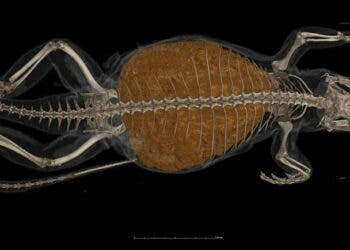
More than 300 million years ago, during the Carboniferous period, Nova Scotia was a subtropical swamp dominated by lycopsids, an ancient moss-like plant. In the hollowed-out stump of one of these lycopsids, an adult lizard-like creature and her young likely made their den, until a grave storm flooded the area with sediments. The tragic event killed the creatures, but in the process also trapped the pair in an intertwined embrace — it is the oldest example of a creature caring for its young that scientists have found so far.
The amazing discovery was made in 2017 by Brian Hebert, a local fossil enthusiast, who contacted Hillary Madin, an assistant professor at Carleton University, Canada. The two recently published a paper describing the new species, known as Dendromaia unamakiensis, whose name is derived from the ancient Greek words for ‘tree’ and ‘mother’ and the Mi’kmaq’ indigenous people’s name for Cape Breton Island, where the fossil was found.
According to the researchers, the species is a varanopid, an extinct family of amniotes that resembled monitor lizards, which some claim to be an early lineage leading to mammals.

The Dendromaia adult was no longer than 20 centimeters from the tip of the snout to the base of the tail. Behind the adult’s hind legs and encircled by its tail lies the fossilized skull of a juvenile of the same species.
This side-by-side positioning suggests that the adult was a parent — after all, it would be quite the coincidence for the two creatures, an adult and juvenile, to die and fossilize together randomly. In effect, this would make the 309-million-year-old fossil the oldest evidence of parental care to date — a good 40 million years earlier than previously thought.
“This specimen adds to growing evidence that parental care was more widespread among Palaeozoic synapsids than previously thought and further provides data permitting the identification of potential ontogeny-dependent traits within varanopids, the implications of which impact recent competing hypotheses of the phylogenetic affinities of the group,” the authors wrote in their study.
Although it’s impossible for the researchers to derive definite conclusions about such complex behavior from the fossil record, the evidence is pretty strong that the adult and youngling interacted.
Today, many birds, mammals, and lizards invest considerable time and resources into protecting, nurturing, and rearing their offspring. In some species, particularly social animals, parenting can be incredibly demanding, as adults invest heavily to teach their young how to forage. Humans, for instance, are born into this world completely helpless and dependant on their parents for survival.
We tend to view many ancient animals as primitive. However, this fossilized duo suggests that even back then creatures that predated the dinosaurs behaved in many ways like modern animals.
It’s not clear at the moment whether parenting evolved multiple times in history or it surfaced a single time in a common ancestor shared by Dendromaia and all the modern animals that care for their young today. But, if anything, this is a good opportunity to appreciate family life. Parenting has been around for at least 300 million years so it’s definitely good for something.
The findings appeared in the journal Nature Ecology & Evolution.






